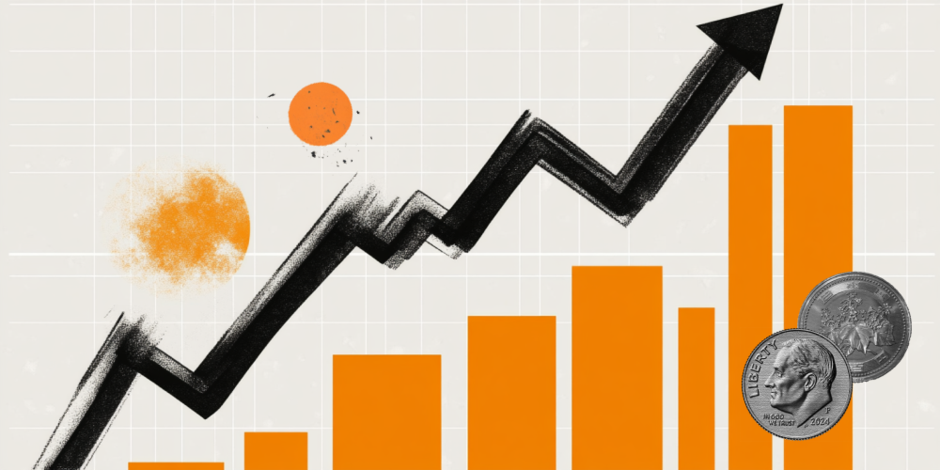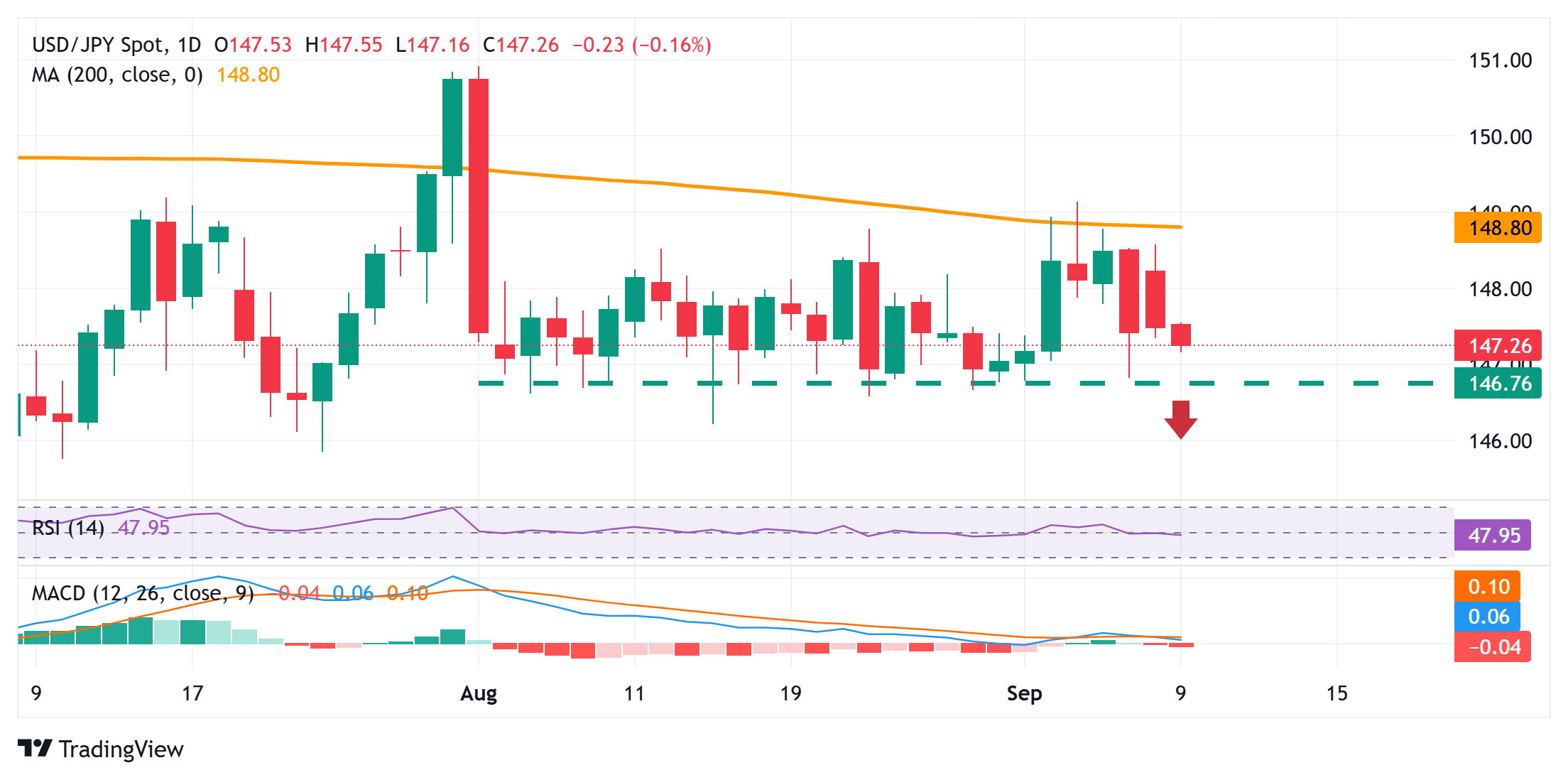Created
: 2025.09.09














![]() 2025.09.09 11:28
2025.09.09 11:28
The Japanese Yen (JPY) trades with a positive bias against its American counterpart during the Asian session on Tuesday, though the uptick lacks bullish conviction amid mixed fundamental cues. US President Donald Trump signed an executive order last Thursday to lower the Japanese auto import tariff, and fueled optimism. Furthermore, an upward revision of Japan's Q2 GDP growth figures, along with a rise in household spending and positive real wages, backs the case for an imminent interest rate hike by the Bank of Japan (BoJ). This marks a significant divergence in comparison to rising bets for a more aggressive policy easing by the US Federal Reserve (Fed), which contributes to the JPY's relative outperformance against the bearish US Dollar (USD).
Meanwhile, Japan's Prime Minister Shigeru Ishiba announced his resignation over the weekend. This adds a layer of uncertainty, which could temporarily hinder the BoJ from normalising policy and hold back the JPY bulls from placing aggressive bets. Apart from this, the upbeat market mood turns out to be another factor that contributes to capping the upside for the JPY. The USD, on the other hand, touched a fresh low since July 28 amid dovish Fed expectations. This, in turn, suggests that the path of least resistance for the USD/JPY pair is to the downside. Traders, however, might opt to wait for the release of the US inflation figures - the Producer Price Index (PPI) and the Consumer Price Index (CPI) on Wednesday and Thursday, respectively.

The overnight failure ahead of the very important 200-day SMA barrier and a subsequent slide below the 148.00 mark favor the USD/JPY bears. Moreover, oscillators on the daily chart have again started gaining negative traction and suggest that the path of least resistance for spot prices is to the downside. Hence, some follow-through selling below the 147.00 mark, leading to a subsequent break through the 146.80-146.70 horizontal support, will reaffirm the negative bias and expose the August swing low, around the 146.20 region, before the pair eventually drops to the 146.00 mark.
On the flip side, the Asian session high, around the 147.50-147.55 area, now seems to act as an immediate hurdle. A sustained strength beyond might trigger a short-covering move and allow the USD/JPY pair to reclaim the 148.00 mark. The momentum could extend further, though it runs the risk of fizzling out rather quickly near the 200-day SMA barrier, around the 148.75 zone. This is closely followed by the 149.00 round figure and the 149.20 area, or a one-month high touched last week, which, if cleared, might shift the near-term bias in favor of bulls. Spot prices might then climb to the 150.00 psychological mark and then aim to challenge the August monthly swing high, around the 151.00 neighborhood.
The Bank of Japan (BoJ) is the Japanese central bank, which sets monetary policy in the country. Its mandate is to issue banknotes and carry out currency and monetary control to ensure price stability, which means an inflation target of around 2%.
The Bank of Japan embarked in an ultra-loose monetary policy in 2013 in order to stimulate the economy and fuel inflation amid a low-inflationary environment. The bank's policy is based on Quantitative and Qualitative Easing (QQE), or printing notes to buy assets such as government or corporate bonds to provide liquidity. In 2016, the bank doubled down on its strategy and further loosened policy by first introducing negative interest rates and then directly controlling the yield of its 10-year government bonds. In March 2024, the BoJ lifted interest rates, effectively retreating from the ultra-loose monetary policy stance.
The Bank's massive stimulus caused the Yen to depreciate against its main currency peers. This process exacerbated in 2022 and 2023 due to an increasing policy divergence between the Bank of Japan and other main central banks, which opted to increase interest rates sharply to fight decades-high levels of inflation. The BoJ's policy led to a widening differential with other currencies, dragging down the value of the Yen. This trend partly reversed in 2024, when the BoJ decided to abandon its ultra-loose policy stance.
A weaker Yen and the spike in global energy prices led to an increase in Japanese inflation, which exceeded the BoJ's 2% target. The prospect of rising salaries in the country - a key element fuelling inflation - also contributed to the move.
![]()
Created
: 2025.09.09
![]()
Last updated
: 2025.09.09

FXStreet is a forex information website, delivering market analysis and news articles 24/7.
It features a number of articles contributed by well-known analysts, in addition to the ones by its editorial team.
Founded in 2000 by Francesc Riverola, a Spanish economist, it has grown to become a world-renowned information website.
We hope you find this article useful. Any comments or suggestions will be greatly appreciated.
We are also looking for writers with extensive experience in forex and crypto to join us.
please contact us at [email protected].
Disclaimer:
All information and content provided on this website is provided for informational purposes only and is not intended to solicit any investment. Although all efforts are made in order to ensure that the information is correct, no guarantee is provided for the accuracy of any content on this website. Any decision made shall be the responsibility of the investor and Myforex does not take any responsibility whatsoever regarding the use of any information provided herein.
The content provided on this website belongs to Myforex and, where stated, the relevant licensors. All rights are reserved by Myforex and the relevant licensors, and no content of this website, whether in full or in part, shall be copied or displayed elsewhere without the explicit written permission of the relevant copyright holder. If you wish to use any part of the content provided on this website, please ensure that you contact Myforex.
Myforex uses cookies to improve the convenience and functionality of this website. This website may include cookies not only by us but also by third parties (advertisers, log analysts, etc.) for the purpose of tracking the activities of users. Cookie policy